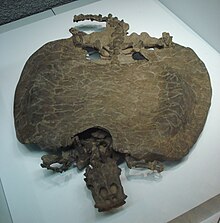Cyamodontoidea: Difference between revisions
added Category:Extinct reptiles using HotCat |
m Added subgroups |
||
| (16 intermediate revisions by 11 users not shown) | |||
| Line 1: | Line 1: | ||
{{Short description|Extinct superfamily of reptiles}} |
|||
{{Automatic taxobox |
{{Automatic taxobox |
||
| fossil_range = [[Triassic]] |
| fossil_range = [[Triassic]] |
||
| image = Henodus chelyops 1.JPG |
| image = Henodus chelyops 1.JPG |
||
| image_caption = Fossil of ''[[Henodus chelyops]]'' in the [[Staatliches Museum für Naturkunde Stuttgart]] |
| image_caption = Fossil of ''[[Henodus chelyops]]'' in the [[Staatliches Museum für Naturkunde Stuttgart]] |
||
| taxon = Cyamodontoidea |
|||
| authority = Nopsca, [[1923 in paleontology|1923]] |
| authority = Nopsca, [[1923 in paleontology|1923]] |
||
| subdivision_ranks = Families |
|||
| display_children = 1 |
|||
| subdivision = * [[Cyamodontidae]] |
|||
* [[Henodontidae]] |
|||
* [[Placochelyidae]] |
|||
}} |
}} |
||
'''Cyamodontoidea''' is an extinct [[superfamily (biology)|superfamily]] of [[placodont]] [[marine reptile]]s from the [[Triassic]] period. It is one of the two main groups of placodonts, the other being [[Placodontoidea]]. Cyamodontoids are distinguished from placodontoids by their large shells, formed from fused bony plates called [[osteoderm]]s and superficially resembling the shells of |
'''Cyamodontoidea''' is an extinct [[superfamily (biology)|superfamily]] of [[placodont]] [[marine reptile]]s from the [[Triassic]] period. It is one of the two main groups of placodonts, the other being [[Placodontoidea]]. Cyamodontoids are distinguished from placodontoids by their large shells, formed from fused bony plates called [[osteoderm]]s and superficially resembling the shells of [[turtle]]s. Cyamodontoids also have distinctive skulls with narrow, often toothless jaws and wide, flaring temporal regions behind the eyes. Two large temporal openings are positioned at the top of the back of the skull, an arrangement that is known as the [[Euryapsida|euryapsid]] condition and seen throughout [[Sauropterygia]], the marine reptile group to which placodonts belong. Cyamodontoids are also distinguished by their large crushing teeth, which grow from the [[palatine bone]]s on the roof of the mouth.<ref name=RO02>{{cite journal |last=Rieppel |first=O. |year=2002 |title=The dermal armor of the cyamodontoid placodonts (Reptilia, Sauropterygia): morphology and systematic value |journal=Fieldiana |volume=46 |pages=1–41 |url=https://archive.org/details/dermalarmorofcya46riep}}</ref> |
||
==Description== |
==Description== |
||
===Shell=== |
===Shell=== |
||
The shells of cyamodontoids differ from those of turtles in several ways. Turtle shells are fused to their skeletons in several regions, including the vertebrae, ribs, [[gastralia]] (belly ribs), and [[pectoral girdle]]s, but cyamodontoid shells |
The shells of cyamodontoids differ from those of turtles in several ways. Turtle shells are fused to their skeletons in several regions, including the vertebrae, ribs, [[gastralia]] (belly ribs), and [[pectoral girdle]]s, but cyamodontoid shells overlie skeletal bones without any fusion. Turtle shells are also composed of two layers of osteoderms, while cyamodontoid shells only have one layer. Cyamodontoids typically have more osteoderms forming their [[carapace]]s and [[plastron]]s (upper and lower shells) than do turtles, and the osteoderms have less well-defined shapes than the geometric scutes of turtles.<ref name=RO02/> |
||
==History== |
==History== |
||
| Line 17: | Line 22: | ||
==References== |
==References== |
||
{{ |
{{Reflist}} |
||
| ⚫ | |||
| ⚫ | |||
{{Taxonbar|from=Q5197357}} |
|||
| ⚫ | |||
| ⚫ | |||
[[Category:Placodonts]] |
|||
[[Category:Triassic first appearances]] |
|||
[[Category:Triassic extinctions]] |
|||
{{Triassic-reptile-stub}} |
{{Triassic-reptile-stub}} |
||
| ⚫ | |||
| ⚫ | |||
Latest revision as of 08:45, 6 April 2024
| Cyamodontoidea Temporal range: Triassic
| |
|---|---|

| |
| Fossil of Henodus chelyops in the Staatliches Museum für Naturkunde Stuttgart | |
| Scientific classification | |
| Domain: | Eukaryota |
| Kingdom: | Animalia |
| Phylum: | Chordata |
| Class: | Reptilia |
| Superorder: | †Sauropterygia |
| Order: | †Placodontia |
| Superfamily: | †Cyamodontoidea Nopsca, 1923 |
| Families | |
Cyamodontoidea is an extinct superfamily of placodont marine reptiles from the Triassic period. It is one of the two main groups of placodonts, the other being Placodontoidea. Cyamodontoids are distinguished from placodontoids by their large shells, formed from fused bony plates called osteoderms and superficially resembling the shells of turtles. Cyamodontoids also have distinctive skulls with narrow, often toothless jaws and wide, flaring temporal regions behind the eyes. Two large temporal openings are positioned at the top of the back of the skull, an arrangement that is known as the euryapsid condition and seen throughout Sauropterygia, the marine reptile group to which placodonts belong. Cyamodontoids are also distinguished by their large crushing teeth, which grow from the palatine bones on the roof of the mouth.[1]
Description[edit]
Shell[edit]
The shells of cyamodontoids differ from those of turtles in several ways. Turtle shells are fused to their skeletons in several regions, including the vertebrae, ribs, gastralia (belly ribs), and pectoral girdles, but cyamodontoid shells overlie skeletal bones without any fusion. Turtle shells are also composed of two layers of osteoderms, while cyamodontoid shells only have one layer. Cyamodontoids typically have more osteoderms forming their carapaces and plastrons (upper and lower shells) than do turtles, and the osteoderms have less well-defined shapes than the geometric scutes of turtles.[1]
History[edit]
The division of placodonts into two groups was first proposed in 1863 by German paleontologist Christian Erich Hermann von Meyer, who named Macrocephali ("large skulls") and Platycephali ("flat skulls"). Macrocephali would later be known as Placodontoidea, and Platycephali would later become Cyamodontoidea. Complete skeletons of placodonts were not known at the time of von Meyer's proposed classification, and the large shells of cyamodontoids were unknown.[1]
References[edit]
- ^ a b c Rieppel, O. (2002). "The dermal armor of the cyamodontoid placodonts (Reptilia, Sauropterygia): morphology and systematic value". Fieldiana. 46: 1–41.







